
ProtonMail is a secure email service that privileges privacy and security. You can use the service to send encrypted messages that should only be read by the intended recipient. There are several alternatives to do it, depending on the security or email provider used by the recipient.
Option 1: Send an email to another ProtonMail user
If you are sending a message to another ProtonMail user, your email will be automatically encrypted. The recipient will not need to do anything to decrypt the message and can simply click or tap the email to read it..
Each part of the procedure undergoes some form of encryption. The connection between your computer and the server is encrypted, the content of the email on the server is encrypted and only the recipient has the correct key to be able to decrypt the message at the other end. Attachments are also insured.
The domains that use @ protonmail.com, @ protonmail.ch and @ pm.me will use this high-level encryption. ProtonMail also enables you to use a private domain name with the service, so it is also possible to use internal encryption in domains other than ProtonMail.
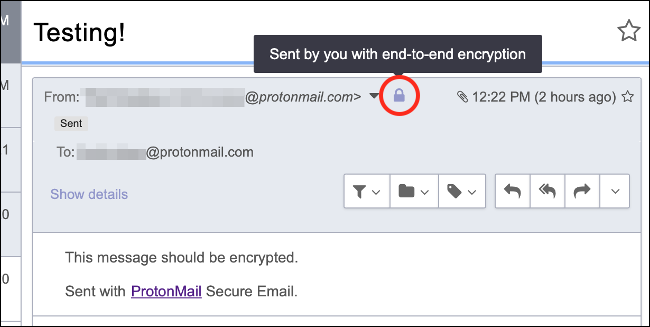

You will know that an email comes from a ProtonMail account (and, because, which has been encrypted internally) when I see a purple padlock in the field “From” next to the email address of your contact.
To communicate with someone safely, you might want to ask you to set up a ProtonMail account just for that purpose. They can even configure ProtonMail to send them a notification email every time they get a new secure message in ProtonMail. The content of the message remains private and they can log into ProtonMail to view it.
RELATED: What is ProtonMail and why is it more private than Gmail?
Option 2: configure PGP with non-ProtonMail users
PGP means “Pretty Good Privacy” and it is an end-to-end encryption method compatible with email that uses both a public key and a private key. PGP enables you to send encrypted emails to people who don't use ProtonMail, as long as they have PGP configured.
To send an email to a recipient through PGP, you will need to know your public key (and to receive an email encrypted with PGP, the recipient must know your public key).
Key exchange is an important part of this procedure. You can attach your public key to any outgoing email by clicking the dropdown button “Plus” in the email composing interface and checking “Attach public key”.
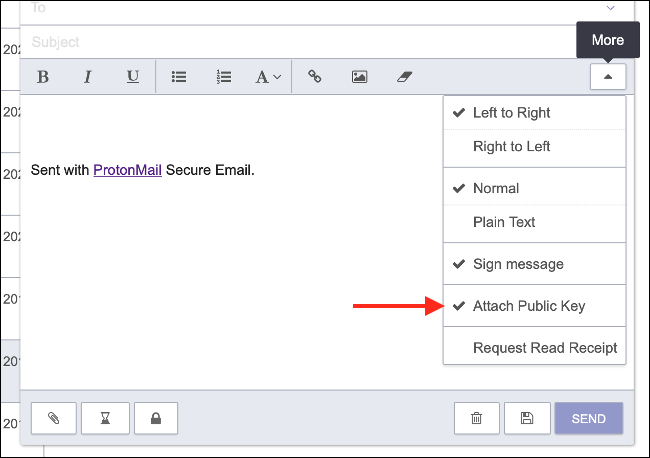

You can set this behavior as the default in Settings> Security by enabling “Automatically attach public key” in ProtonMail preferences.
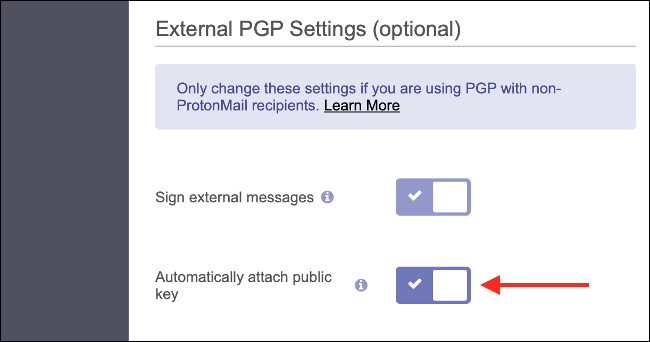

The recipient must send their public key to receive their encrypted email, so you will have to communicate it. You can add a recipient's public key to your ProtonMail account using a few different methods:
- Clicking the button “Trust Key” that appears above an email containing a PGP public key and making sure to check the box “Use for Encryption” in the pop-up window that appears.
- When adding a contact in the Contacts tab, then click on Advanced Settings followed by “Load key” and locate the file that your contact sent you. Be sure to choose “Use for encryption” for outgoing mail.
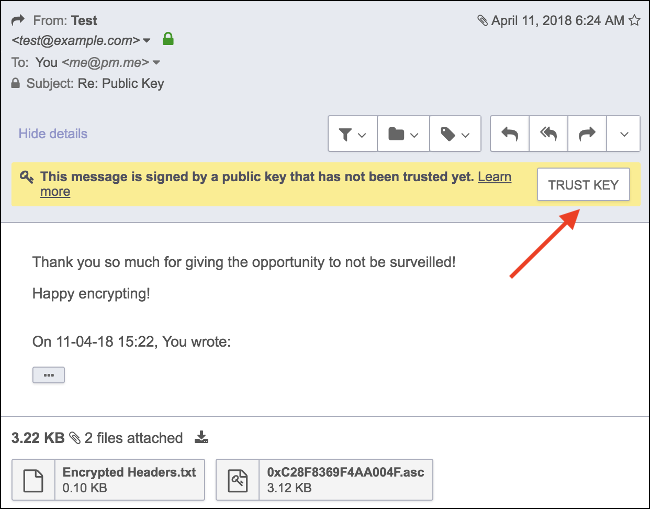

With the keys exchanged and associated with the correct email addresses, should be able to communicate securely, regardless of the email provider the recipient uses.
You will see a green padlock near the field “From” when an email has been encrypted with PGP. If your contact is also digitally signing the messages, this green padlock will have a mark.


PGP is a powerful tool, but its configuration can be confusing. It's certainly not for everyone, and sign up for a free ProtonMail account (who takes care of the key exchange for you, invisibly) could be an easier option. O, instead of using PGP, that can be complicated, you can try the following method.
Option 3: send password-protected self-destructing emails to anyone
At the same time offering internally encrypted mail and great support for PGP, ProtonMail has one more security to send secure mail. It's a trick, but it works fine for your friends who insist on using Gmail, Outlook.com or any other email service provider.
Is that how it works:
- Compose an email message as usual.
- The message is encrypted and locked with a password of your choice, and press Send.
- The recipient receives a message telling them that there is an encrypted email waiting for them, along with a link.
- Recipient clicks the link, pointing to a ProtonMail web page with a password field.
- The recipient decrypts the message and can read it in their web browser.
- Message expires 28 days after (the before) without the content being revealed to any server other than ProtonMail.
This method is much simpler than setting up PGP or convincing your friends to switch email providers., but probably not practical for frequent communication.
It is also important to note that the recipient could pass the link to anyone else (along with the password), which would compromise confidentiality. Never assume that a message will remain private just because you have used a service like ProtonMail. You also trust the person to whom you send the email to maintain the privacy of your communications.


To use the function, compose an email in ProtonMail, then click on the padlock icon “Encryption” in the lower left corner of the window. Enter and confirm your password before adding a password hint, If you wish. The track is optional.
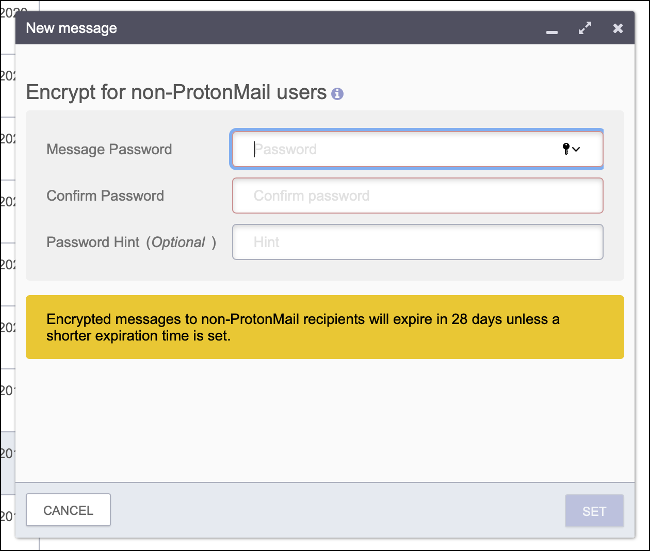

Click on “Decide” to encrypt the message, then click on the hourglass icon “Expiration time” if you want the message to expire before 28 days.
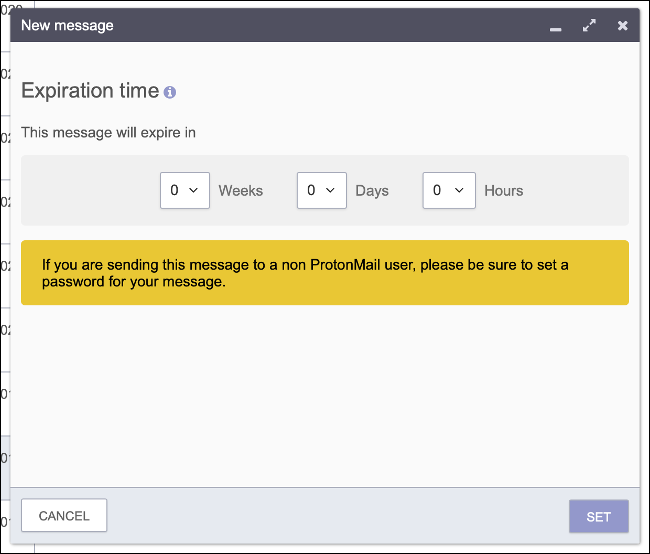

Then you can press Send to send your email as usual.. The recipient will not see any of your messages (apart from the password hint) in your inbox, even though it will appear that the message comes directly from your ProtonMail account.
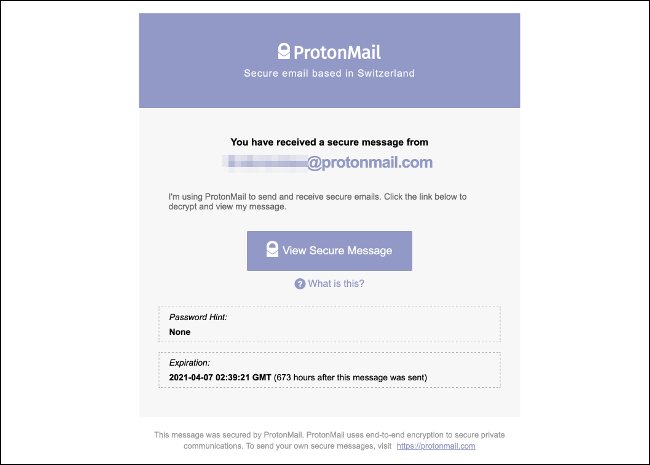

This method has its uses, but also its drawbacks. Some recipients may not trust your message, since clicking on links in the email is not always the best idea. Although regular email messages can last permanently, these messages expire after 28 days and it is almost impossible to search for them unless you know the matter.
Is it time to switch to ProtonMail?
ProtonMail is a well established secure email provider, but he's not the only one. marrow and Posting they are two good alternatives, but there are many more.
If you come from Gmail and wonder what you will give up, take a look at our comparison of ProtonMail and Gmail.






